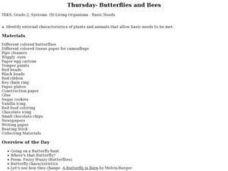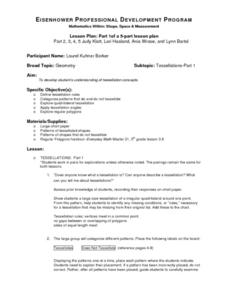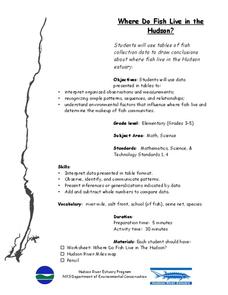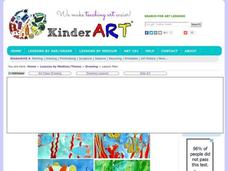Curated OER
In Your Own Backyard
Young scholars observe organisms in their habitat and record their observations. They then draw conclusions about the organism's habitat needs and food sources.
Curated OER
Ane Frank: Writer
Tenth graders investigates a website to gather information on the Holocaust and Anne Frank. They compare Anne Frank's characteristics to other peers. Students explore specific examples and draw conclusions about human behavior.
Curated OER
Blast's Cosmic Carnival
Students, after analyzing the history of a concentrator, model how a Genesis spacecraft concentrator works by playing a game. In groups of three or four, after being given materials to work with, are challenged to roll the rubber balls...
Curated OER
What Do People Need?
Second graders discuss the difference between needs and wants and create a T chart. They brainstorm as many ways as possible to meet their basic needs. They analyze different ways the community gets involved to help individuals with...
Curated OER
Big Blue Sky- Based on the Montana Quarter Reverse
Students use a Montana quarter to help describe geographical features such as landforms and bodies of water. Students read an article about Montana as a group and discuss examples of landforms and bodies of water. After reading,...
Curated OER
Biology: Butterfly Activities
Second graders examine various types of butterflies and insects around their school. They identify differences between beetles and butterflies. Students examine books about butterflies, complete symmetry drawings, and make ladybug key...
Curated OER
Spirit of Enquiry
The lesson includes guided questions to help students to think about their own behavior and purpose in life. They do this through a quiet time of reflection that can include the writing of ideas. Then students act out a play to...
Curated OER
Tell Me All About It!!
Students discuss the importance of comprehension and the use of summarization. Through guided practice, they follow five steps in finding and highlighting important information, while deleting information that is not needed. Using the...
Curated OER
What's Important?
Students, through teacher modeling and guided practice, explore four steps/rules of summarizing. In groups, they read a short passage and then, by applying the summarization rules and skills, write an effective summary of it.
Curated OER
Geometry /Tessellations
Students investigate the concept of tessellations and how they are formed using angles. They categorize how different patterns do and not tessellate and separate them into two different places for assessment. The teacher draws examples...
Curated OER
Capitol Calculations
Middle schoolers engage in a lesson of writing story problems about the capitol building. They conduct research using the internet to find data involving numbers to build a resource bank to draw information for the writing of problems....
Curated OER
Where Do Fish Live in the Hudson?
Learners explore the environmental factors that influence where fish live and determine the makeup of fish communities in the Hudson. They interpret guided observations and measurements to assess patterns, sequences and relationships.
Curated OER
Looking At the World Through Different Eyes
Students are introduced to the concept of reframing as a problem-solving alternative. They present the value of incorporating adults into their suport system. Students draw what they think Creep Face and Maggie saw when they looked...
Curated OER
Exhibit Scavenger Hunt
Students fill in a worksheet from a scavenger hunt about submarines. A tour guide has to stamp it to make it validated. They have various questions to answer ranging from when the first underwater vessel was created, who created it,...
Curated OER
Economics: What are ways that rice can be used?
Second graders examine the uses of rice. In this social science lesson plan, 2nd graders list and draw pictures of five ways people use rice.
Curated OER
Under the Sea
Tropical fish are a great subject for any art project, they are colorful, interesting, and can go along with under water themed stories read in class, learner written narratives, or Marine Biology units. This set of instructions will...
NOAA
Deep-Sea Ecosystems – Entering the Twilight Zone
Imagine an ecosystem without any light or oxygen, where living things convert carbon dioxide into food. This ecosystem is thriving and might just be the largest ecosystem on our planet, yet we know very little about it. The lesson...
NOAA
Deep-Sea Ecosystems – Life is Weird!
A pool of brine in the deep sea can be up to four times as salty as the surrounding sea water. The deep sea ecosystem relies on chemosynthesis and the organisms that live there are often strange to us. The lesson focuses on researching...
Curated OER
Homes Sweet Homes
Students analyze various paintings of houses by Robert Harris. They examine what home really means to themselves by drawing house designs, collecting artifacts and making a class museum, taking photos and conducting a guided tour of...
Curated OER
What Do You See?
Students, through teacher modeling and guided practice, explore the concept of visualization and how it works to help them comprehend what they read. They read the first chapter of the book, 'Sarah, Plain and Tall' and visualize what...
Curated OER
Watershed Delineation
Students use topographic maps to delineate a watershed.In this ecology lesson, students draw the boundaries of a watershed onto a map using contour lines as a guide. Their resulting maps are used to evaluate their understanding.
Curated OER
A Tree Grows in Brooklyn
In this story structure lesson, students read the book A Tree Grows in Brooklyn and identify the characters, setting and main themes of the book. They answer a list of study questions about the book.
Curated OER
The Shape of Me and Other Stuff, by Dr. Seuss: A Class Mural
A cut and paste mural activity is a fun activity to complete after reading a Dr. Seuss book. In this shape recognition and art lesson, students read the book The Shape of Me and Other Stuff and discuss the main idea. A class mural can be...
Curated OER
Beautiful Birds
Students engage in a lesson that is about birds while taking part in a variety of activities that are like the following. They play a game that is used for increasing memory while using bird pictures. Students also create a collage with...

























